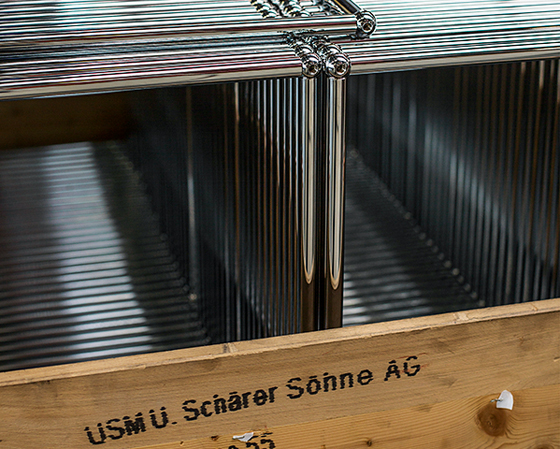World class
Texto por USM
Münsingen, Suiza
18.07.17
At USM, an ecological idea gave rise to a classic that is even on show at the MoMa in New York.
Simple and variable: USM furniture adapts to its user’s changing living environment
Few companies’ DNA is as distinctive as that of USM. Hardly surprising, given that the modular furniture system has always remained faithful to the original blueprint by designer and architect Fritz Haller and, while it has certainly evolved over the years, has never radically changed. As a result, the chrome-plated ball joint that was devised in 1963 is still the heart of USM’s furniture systems to this very day.
Versatile: whether it’s destined for an office or a bedroom, the furniture can be used in a variety of ways

Versatile: whether it’s destined for an office or a bedroom, the furniture can be used in a variety of ways
×The pioneering spirit of the then managing director and engineer Paul Schärer and architect Fritz Haller soon paid off: the tubular steel furniture that was originally only intended for their own offices in Münsingen turned into a global success story. Today USM’s products are considered classics that are used not just to furnish offices and homes all over the world but to equip public buildings like hospitals, libraries and stores as well. Since 2001, USM furniture has even been part of the permanent collection at the Museum of Modern Art (MoMa) in New York. That same pioneering spirit made itself felt in other ways as well. Because thanks to the modular idea behind the furniture system, the product can be reinvented and changed at any time, thus prolonging its useful life. Or as Paul Schärer later said: “Back then, the furniture’s sustainability was purely incidental – first and foremost, it was the result of economic considerations.”
High capacity: with a little help from the machinery, the frame of a partial module can be joined together directly (top). Individual assembly: the ordered furniture is put together by hand in Münsingen (bottom)

High capacity: with a little help from the machinery, the frame of a partial module can be joined together directly (top). Individual assembly: the ordered furniture is put together by hand in Münsingen (bottom)
×The focus was on developing a timeless design and a modular construction system that adapts to its users’ changing needs. And that basic idea is still proving its worth today. In 2007, USM earned the Greenguard Indoor Air Quality certificate in the Furniture Systems and Tables category for its USM Haller and USM Kitos systems. The label is an internationally recognised “green guideline” and signifies that the two products release only very small amounts of emissions into the air. That reduces air pollution in homes and offices and helps create a healthier indoor climate. What’s more, USM furniture can be almost completely recycled should the need arise. The majority of the raw materials are sourced from Switzerland and processed entirely in Münsingen, where the furniture is assembled entirely by hand for inland transport or pre-assembled into smaller, transportable units for global shipping. What is made by machine is put together individually by people. “The human touch is still our best form of quality control,” says Alexander Schärer, president of the board of directors and CEO of USM. “Every single part is picked up and examined multiple times.”
Global seller: USM furniture is produced to order in Münsingen and sold in over 40 countries worldwide (top). Coherent: different USM furniture lines can be combined to create an individual atmosphere (bottom)

Global seller: USM furniture is produced to order in Münsingen and sold in over 40 countries worldwide (top). Coherent: different USM furniture lines can be combined to create an individual atmosphere (bottom)
×USM: In 1961, engineer Paul Schärer commissioned architect Fritz Haller to design the office pavilion of USM U. Schärer Söhne AG in Münsingen. The two pioneers wanted to design the furniture for the office together as well. In 1963, they hit on the idea of adopting the building’s macrostructure and translating the modular architecture into a microstructure. It was an idea that became a worldwide hit. Today Alexander Schärer is the fourth generation of his family to head the successful company.
Photos: USM
Text: Carina Iten
USM U. Schärer Söhne AG
Thunstrasse 55
Tel.0041 (0)31 720 72 72
Fax 0041 (0)31 720 72 38
info@ch.usm.com













